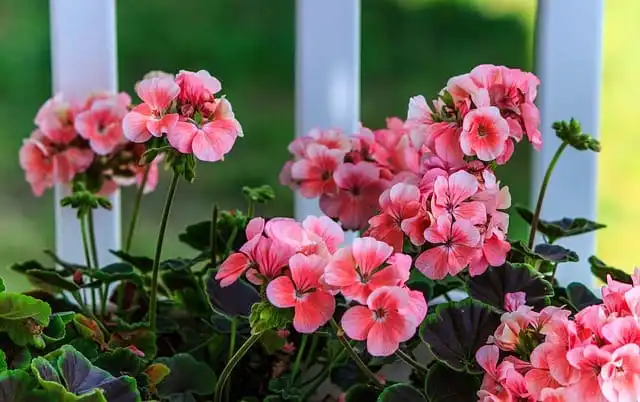Introduction
Geraniums, with their vibrant blooms and aromatic foliage, are popular choices for gardens and containers. This comprehensive guide outlines essential steps for cultivating healthy and flourishing geraniums, incorporating insights from reputable government and horticultural bodies, as well as academic experts.
Selecting Geranium Varieties
Begin by choosing geranium varieties suitable for your climate and garden aesthetic. Refer to resources from the United States Department of Agriculture (USDA) to understand plant hardiness zones and explore recommendations for specific geranium cultivars.
Soil Preparation and pH Adjustment
Geraniums prefer well-drained, moderately fertile soil with a slightly acidic to neutral pH. Conduct a soil test and amend the soil with organic matter, following guidelines from your local Agricultural Extension Service for optimal growing conditions.
Starting Geranium Seeds Indoors
Initiate the growing process by starting geranium seeds indoors 10-12 weeks before the last expected frost. Use a high-quality seed-starting mix and follow academic recommendations for germination and seedling care.
Transplanting Geranium Seedlings
Transplant geranium seedlings into the garden or containers after the last frost, ensuring proper spacing for healthy growth. Refer to specific recommendations from horticultural experts for each geranium variety.
Sunlight Requirements
Geraniums thrive in full sunlight, but they can tolerate partial shade. Ensure they receive at least 6 hours of direct sunlight daily for optimal flowering.
Watering Practices
Maintain a consistent watering schedule, allowing the soil to dry slightly between waterings. Avoid overwatering, as geraniums are susceptible to root rot. Water at the base of the plants to prevent fungal diseases.
Fertilization Techniques
Consult soil test results and fertilize geraniums with a balanced, water-soluble fertilizer during the growing season. Follow academic insights for specific nutrient recommendations, avoiding excessive nitrogen for optimal blooming.
Deadheading for Prolonged Blooms
Encourage continuous flowering by deadheading spent blooms regularly. Follow guidelines from horticultural experts for proper deadheading techniques, promoting a more extended flowering period.
Pest and Disease Management
Monitor for common pests such as aphids and caterpillars, as well as fungal diseases. Implement Integrated Pest Management (IPM) strategies recommended by organizations like the National Integrated Pest Management Network (NIPMN) for effective and sustainable control.
Overwintering Geraniums
While geraniums are typically treated as annuals, you can overwinter them indoors or in a protected environment. Follow advice from horticultural bodies for successful overwintering techniques.
Conclusion
By integrating guidance from government bodies, horticultural organizations, and academic experts, you can successfully cultivate vibrant and aromatic geraniums in your garden or containers. Follow these expert guidelines for a rewarding geranium-growing experience.
Why are geraniums popular in gardens, and what makes them unique?
Geraniums are popular for their vibrant blooms, aromatic foliage, and versatility in gardens and containers, adding color and fragrance to outdoor spaces.
When is the best time to start geranium seeds indoors?
Start geranium seeds indoors 10-12 weeks before the last expected frost, providing sufficient time for robust seedlings.
Do geraniums prefer full sunlight, and can they tolerate shade?
Geraniums thrive in full sunlight but can tolerate partial shade. Ensure they receive at least 6 hours of direct sunlight daily for optimal flowering.
What type of soil do geraniums prefer, and how should I prepare it?
Geraniums prefer well-drained, moderately fertile soil with a slightly acidic to neutral pH. Amend the soil with organic matter following recommendations from local agricultural extension services.
How do I transplant geranium seedlings, and what spacing is recommended?
Transplant geranium seedlings after the last frost, ensuring proper spacing based on the specific recommendations for each geranium variety.
Can geraniums be grown in containers, and what care do they need in pots?
Yes, geraniums thrive in containers. Use well-draining potting mix, provide adequate sunlight, and follow watering and fertilization practices for healthy container growth.
How should I water geraniums, and how often do they need watering?
Maintain a consistent watering schedule, allowing the soil to dry slightly between waterings. Water at the base of the plants to prevent fungal diseases.
Do geraniums need special care for continuous blooming, and why is deadheading important?
Deadhead spent blooms regularly to encourage continuous flowering. Follow guidelines from horticultural experts for proper deadheading techniques.
What pests and diseases should I watch out for when growing geraniums?
Monitor for common pests such as aphids and caterpillars, as well as fungal diseases. Implement Integrated Pest Management (IPM) strategies for effective control.
Can geraniums survive the winter, and what are the overwintering options?
While geraniums are typically treated as annuals, they can be overwintered indoors or in a protected environment. Follow advice from horticultural bodies for successful overwintering techniques.
- Tennessee’s THC Beverage Market - June 5, 2025
- Top THC Infused Seltzers in Delaware - June 5, 2025
- Florida’s Hottest THC Infused Beverages - May 28, 2025




